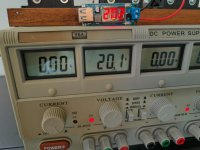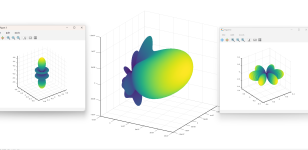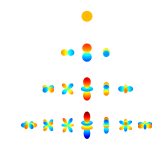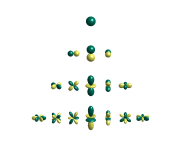I added lots of tests to the code (and found a bug), refactored some more and added more documentation.
I completely disassembled the rotating table and am trying a smaller stepper motor with the esp32duino. I will need to design and print some parts.
In the mean time I'm starting with a build description / bill of materials. It can be found here: https://github.com/TomKamphuys/NFS/blob/feature/arcs/Documents/BuildDescription.md
Still very rough though.
I completely disassembled the rotating table and am trying a smaller stepper motor with the esp32duino. I will need to design and print some parts.
In the mean time I'm starting with a build description / bill of materials. It can be found here: https://github.com/TomKamphuys/NFS/blob/feature/arcs/Documents/BuildDescription.md
Still very rough though.
I'm slowly rebuilding the setup and taking a lot of pictures for a build description in the mean time.
I've been looking for a way to limit the amount of wires, especially to the rotating part. First I tried a powerbank with PowerDelivery that is capable of 20V over USB together with a small 'decoy' to negotiate 20V and power the servo's with it.

For some info, use these search terms: pdc004 pd 20v
I ordered some, but got some fake stuff as far as I can tell.
So I switched and ordered two small PCB's that have a 5V USB connection for the ESP32 boards and take 20V as the input, which I also need for the servo's.

Those who watch closely might notice that the small PCB is upside down, but luckily the voltage is 20.2V, so the only thing giving it away is the '.' .
I'll continue slowly 🙂
Over on audiosciencereview someone is looking into the fitting and reconstruction using python.
I've been looking for a way to limit the amount of wires, especially to the rotating part. First I tried a powerbank with PowerDelivery that is capable of 20V over USB together with a small 'decoy' to negotiate 20V and power the servo's with it.
For some info, use these search terms: pdc004 pd 20v
I ordered some, but got some fake stuff as far as I can tell.
So I switched and ordered two small PCB's that have a 5V USB connection for the ESP32 boards and take 20V as the input, which I also need for the servo's.

Those who watch closely might notice that the small PCB is upside down, but luckily the voltage is 20.2V, so the only thing giving it away is the '.' .
I'll continue slowly 🙂
Over on audiosciencereview someone is looking into the fitting and reconstruction using python.
could you please put up a link to the audioscience forum? I cannot find the thread you mention. thx!
https://www.audiosciencereview.com/...ematics-and-everything-else.9970/post-2307077could you please put up a link to the audioscience forum?
I played chess as a child and teenager. My interest in it waned when I beat my father for the first time.....I haven't been working on the table top NFS for the last months. To be honest, I just didn't feel like it. I kinda proved it could be done. It's one of my pitfalls to loose interest at that point where others can seem to go on forever on the same topic.
I think that could be one of my weaknesses in other areas too.
Tom I'm following carefully, here and on ASR. I will be building it if the math is solid. And the interface is useable by a reasonably intelligent ludite like me.
We have a few programs that allow us to see the graphs. REW, ARTA, Vituix all allow us to see FRD files. So, if the ability to see the results of our measurements is a difficult thing to ask for, then The ability to see a data file saved and named. If you stick to Octave, it allows an reasonable GUI interface from the little that I know about it.How would that interface look like? What do you want to do and achieve?
Even Klippel is not that full featured.
Ideally to see the measurement as we do in REW would be awesome.
Could you be a bit more specific? What are 'the graps'? What do you want to do with the FRD files? What are 'the results of our measurements'?
The measurements of the NFS are a bunch of wav files. You can postprocess these and get a set of coefficients describing the speaker that was measured. With these, you can the take virtual measurements at every position you want. You could feed this back into REW, but what do you want to do with it? Time gating is useless, because the virtual measurements are in an anechoic room.
Things I can think of are the CEA2034 graph (spinorama) and some contour plots. Erin shows a nice collection on his website:
https://www.erinsaudiocorner.com/loudspeakers/elac_db62/
Could you make an ordered wishlist?
And what do you expect from the GUI? I could output graphs in jpeg, or as data for reading in other programs. How would a GUI help here?
The measurements of the NFS are a bunch of wav files. You can postprocess these and get a set of coefficients describing the speaker that was measured. With these, you can the take virtual measurements at every position you want. You could feed this back into REW, but what do you want to do with it? Time gating is useless, because the virtual measurements are in an anechoic room.
Things I can think of are the CEA2034 graph (spinorama) and some contour plots. Erin shows a nice collection on his website:
https://www.erinsaudiocorner.com/loudspeakers/elac_db62/
Could you make an ordered wishlist?
And what do you expect from the GUI? I could output graphs in jpeg, or as data for reading in other programs. How would a GUI help here?
In the mean time, I've written some (preliminary) documentation.
https://github.com/TomKamphuys/NTKSPH/blob/feature/3D/README.md
https://github.com/TomKamphuys/NTKSPH/blob/feature/3D/README.md
Given the variety of data visualization schemes used by the community, I'd be inclined not to tie the VW-Klippel to any one data visualization package. I suggest designing the GUI to make it easy to define the measurement parameters, and define the way data are saved, and not constrain things with other details.
I've not yet looked at the documentation, but I wanted to applaud the effort nonetheless. That's a major undertaking and an act of generosity! I look forward to reading it.
Few
I've not yet looked at the documentation, but I wanted to applaud the effort nonetheless. That's a major undertaking and an act of generosity! I look forward to reading it.
Few
I did not know the saved format as you describe it. I only use the Klippel-Lab-RND application.Could you be a bit more specific? What are 'the graps'? What do you want to do with the FRD files? What are 'the results of our measurements'?
The measurements of the NFS are a bunch of wav files. You can postprocess these and get a set of coefficients describing the speaker that was measured. With these, you can the take virtual measurements at every position you want. You could feed this back into REW, but what do you want to do with it? Time gating is useless, because the virtual measurements are in an anechoic room.
Things I can think of are the CEA2034 graph (spinorama) and some contour plots. Erin shows a nice collection on his website:
https://www.erinsaudiocorner.com/loudspeakers/elac_db62/
Could you make an ordered wishlist?
And what do you expect from the GUI? I could output graphs in jpeg, or as data for reading in other programs. How would a GUI help here?
Few's comment is pretty much the best option.
I will definitely look at the documentation Tom.
I just looked at the link that you posted. Those graphs are well representative of measurements that are useful.
Truly, this is an awesome ability for people to be able to make measurements that are this good. I'm very thankful for the work done. This is something that is beyond my capabilities. Truly humbling to watch it come together. My maths were learned almost 40 years ago. And never to this level of excellence.
I suggest designing the GUI to make it easy to define the measurement parameters
Code:
[measurement_points]
type = SphericalMeasurementPointsArcs
nr_of_points = 5000
wall_spacing = 30 # mm
radius = 320 # mmThat's it for the NFS part. I understand the feeling that a GUI would make things easier. But at the moment stuff is so basic, that a GUI would be overkill.
I'm not the guy to deliver a polished product. I care about the functionality, or the concepts, the journey.
Good news and bad news...
I might have been using the wrong spherical harmonics (complex vs. real). It needs more investigation.
During the investigation I felt the need for visualisation of the spherical harmonics. Once I had that, (a kind of) balloon plot was easy. Here is one with some single modes to the left and right.

I might have been using the wrong spherical harmonics (complex vs. real). It needs more investigation.
During the investigation I felt the need for visualisation of the spherical harmonics. Once I had that, (a kind of) balloon plot was easy. Here is one with some single modes to the left and right.

What do these plots show? What are the surfaces, and what are colors? Oh, and what are the axes?Once I had that, (a kind of) balloon plot was easy. Here is one with some single modes to the left and right.
Mine are a work in progress. See the link for some info for real ones.
https://www.bodziosoftware.com.au/Sound_Fields.pdf
The spherical harmonics:
The absolute value of the spherical harmonic (left (3,0); right (3,-3)) function as evaluated on a sphere with radius 3 (meter). For the image the angles are kept and the range is replaced with the abs function value. That value is also used for the color.
Very similar plots can be found here, with a better explanation:
https://en.wikipedia.org/wiki/Spherical_harmonics
For the middle, the (arbitrarily scaled) virtual abs (sound) pressure (not SPL yet) is used as range. The image is for a single frequency. This 'measurement' is a weighted sum of the spherical harmonics. The weight is the fit coefficient. Only outgoing waves are used, so Sound Field Separation has been performed.
The images were the highlight of an evening of bug hunting, total chaos and wondering what (***) was going on.
https://www.bodziosoftware.com.au/Sound_Fields.pdf
The spherical harmonics:
The absolute value of the spherical harmonic (left (3,0); right (3,-3)) function as evaluated on a sphere with radius 3 (meter). For the image the angles are kept and the range is replaced with the abs function value. That value is also used for the color.
Very similar plots can be found here, with a better explanation:
https://en.wikipedia.org/wiki/Spherical_harmonics
For the middle, the (arbitrarily scaled) virtual abs (sound) pressure (not SPL yet) is used as range. The image is for a single frequency. This 'measurement' is a weighted sum of the spherical harmonics. The weight is the fit coefficient. Only outgoing waves are used, so Sound Field Separation has been performed.
The images were the highlight of an evening of bug hunting, total chaos and wondering what (***) was going on.
Last edited:
Are there tools to generate cea2034 graphs from separate measurements? If e.g. REW could do that it would be nice.
I can quite easily generate and export data. If I don't have to do the calculations, that saves me some time and effort.
I can quite easily generate and export data. If I don't have to do the calculations, that saves me some time and effort.
- Home
- Design & Build
- Software Tools
- Klippel Near Field Scanner on a Shoestring

